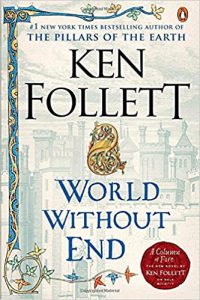World without End, by Ken Follett
World without End
By Ken Follett
New American Library
Four stars
Reviewed by Jessica Gribble
Weighing in at 2.6 pounds and lasting 1024 pages, World without End could double as a doorstop. It might be a good one to buy for your Kindle or Sony Reader. My husband immediately started calling it Book without End, and there were times when I thought I might never finish reading. However, Ken Follett is a master of the engaging tale, and there was plenty going on. If you liked The Pillars of the Earth, you’ll love this sequel. Follett is terrific at drawing characters who are compelling, funny, sexy, dramatic, and very human. Although the book is set in the fourteenth century, modern readers will immediately identify with the emotions and goals of its characters.
The plot immediately sounds familiar if you’ve read Pillars of the Earth. Merthin is a young boy when he’s caught up in a mystery. He and his younger brother Ralph, along with their new companions Caris and Gwenda, witness a murder. Their lives are thus entwined throughout the rest of the novel—sometimes for good, as in Caris and Merthin’s passionate romance, and sometimes for bad, as in Earl Ralph’s abuse of Gwenda’s family. Merthin is a builder, descended (unnecessarily, I thought) from Jack Builder, who starred in the previous book. His novel-spanning goal is to build a bridge and then a church tower, although he is thwarted by a corrupt and stale church bureaucracy at every turn. Caris is the intelligent and favored daughter of a merchant. She saves the family’s fortune but is forced by circumstances into the nunnery, where she turns even that life to her advantage.
One of the most charming things about this book (and the previous one) is its personal look into lives that are difficult to imagine, having taken place seven centuries ago. Characters take last names based on their professions: Madge Brewer, Merthin Builder. (I thought of all the “Smiths” and “Coopers” I know.) The ravages of the plague are chilling. The change in the church from a force for great good (a la Prior Philip) to a wealthy, conservative menace is personified in Prior Godwyn and his cunning toady, Philemon. Caris’s time in the nunnery provides a nice window into the lives of religious women and their deprivations and accomplishments. I gained an extra insight into the Middle Ages by reading an interview with Ken Follett on Amazon.com: He points out that “it’s hard to imagine being so dirty. People bathed very rarely, and they must have smelled pretty bad.” And then he wonders, “What was kissing like in the time before toothpaste was invented?”
One of the least charming things about World without End is the preponderance of rape and violence; it’s probably realistic, but I was frustrated by Follett’s insistence on including women being raped who begin to enjoy it. The inclusion of strong female characters makes the book compelling for modern women. But I wished that Caris had been allowed to go one step further and enjoy other sexual romances like Merthin did—after all, she basically invented the modern hospital and saved the town from the plague. However, readers will appreciate Caris’s desire to be true to her abilities and work as a force for change. Like women today, she has to balance her work with choices about a romantic relationship and motherhood.
In the end, I was captivated by this book. It was a pleasure to see Follett’s skills shine through: a deft handling of the still-current tension between the church and science, and a true knack for drawing characters who grow and struggle, love and grieve.
